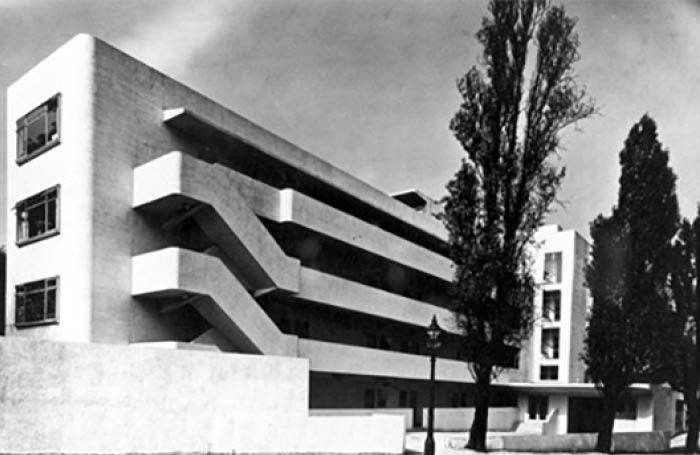Helen Castle, RIBA Publishing Director, examines the story of Bauhaus.
Do we all think we know about the Bauhaus and its influence? The story of the Bauhaus has become a standard chapter in most historical surveys, centring on the activities and philosophy of the school in Weimer and then Dessau. On the centenary of its founding, historian Alan Powers and RIBA Curator of Photographs Valeria Carullo are seeking to debunk and expand the stereotypical view of the Bauhaus. At RIBA Book Club on Friday 18 October, they will highlight a less well-known episode in Bauhaus’s history: the migration of its main proponents – Marcel Breuer, Walter Groupius and László Moholy-Nagy – to London in the mid 1930s. Powers’ book Bauhaus Go West traces the journey of individuals and ideas from Germany to Britain and then on to the United States. Carullo’s monograph Moholy-Nagy in Britain 1935-1937 solely focuses on the designer’s life and work over the two-year period in which he lived in London before moving on to a new life in Chicago.
Rather than aggrandise his subjects, Powers is keen to provide a better understanding of them and temper an often over inflated view of their contribution. He challenges the "desire retrospectively for them to be regarded as important". He does not believe that their presence in 1930s Britain made much difference to the development of British modernism: they "fitted into the modernist scene here, it was not dependent on them". They did not create it. The likes of Berthold Lubetkin and Ernö Goldfinger were already settled in London.
What is missing for Powers often in the retelling of the Bauhaus story is a true understanding of the German context and an acknowledgement of Gropius and his colleagues’ aptitude and need for self-promotion. At the beginning, the Bauhaus school was "an eclectic assemblage" made up of "previous components" in the provincial city of Weimar. Its location in Weimar, and then Dessau, was a challenge and should have made it marginal. If it had been state run and funded, there would have been no need for the same effort to be put in disseminating ideas. The 1923 luxurious book that Gropius produced of the school’s exhibition in Weimar was out of kilter with its actual status, but it was effective in broadcasting the Bauhaus message internationally.
The narrative and fascinating images that form Carullo’s book on Moholy-Nagy reveal the two years that the artist spent in London to be some of the most productive of his life. Despite not finding the permanent teaching position that he sought, and was eventually offered in Chicago, he was well supported by friends, such as Jack and Molly Pritchard, who commissioned the Isokon Flats. Moholy-Nagy and his wife stayed at Lawn Road when they first arrived in London and designed marketing materials for Pritchard’s Isokon Furniture Company. Moholy-Nagy’s "creative and versatile mind" meant "he relished the opportunities that London provided". He also worked as a graphic designer on books, advertisements and London Transport posters. He took photographs for Architectural Review, he made a couple of documentary film and illustrated three books for John Betjeman’s publisher. Moholy-Nagy’s most profitable job, though, was as design consultant for Simpson in Piccadilly where he designed innovative interior displays, including one incorporating three full-size aircraft on the fifth floor for its opening.
It could not be more fitting that the RIBA has produced its own exhibition, Beyond Bauhaus, to mark the Bauhaus centenary, drawing on its collections (Carullo is a co-curator). The RIBA played a pivotal part in supporting the applications of émigrés in the 1930s. Before moving to this country in May 1934 Gropius had an exhibition at the RIBA’s premises in Conduit Street and then lectured at the DIA (Design and Industries Association). It was a moment of modernist galvernisation and inspiration for an enthusiastic London audience, paving the way for Gropius’ more permanent stay a few months later. Throughout the 1930s, the RIBA’s Refugee Committee supported applications from less well-known architects, most of European-Jewish origin, fleeing Nazi persecution. The RIBA’s Librarian and journal editor Bobby Carter was also involved in supporting Gropius’s farewell dinner at the Trocadero hosted by his friends, most notably Maxwell Fry and Jack Pritchard, before he set sail for America and a professorship at Harvard.
You can hear Alan Powers and Valeria Carullo speak on Migrating Bauhaus – the design diaspora at RIBA Book Club on Friday 18 October at 1pm at 66 Portland Place, London. Buy tickets.
Beyond Bauhaus - Modernism in Britain 1933–66 is at the Architecture Gallery, RIBA, until 1 February 2020.
Quotes are drawn from a conversation with Alan Powers and Valeria Carullo at the end of September 2019.










